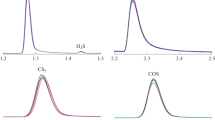Summary
The process presented and its application to the separation of C4 hydrocarbons, comprises a continuous chromatography in a moving bed, one originality of which is to be without vector-gas. The device described includes a vertical column in which a granular phase flows downwardly, by gravity in a compact bed. The gas-mixture to be separated is continuously introduced into the central portion of the column. Separation of the constituents is achieved by a counter-current exchange between the gaseous phase and the absorbed phase: the less absorbed gas is drawn off at the top of the column, and the more absorbed one is drawn off at the bottom; they are recovered by thermal trapping. Desorption is achieved by heating in the lower section and a part of the gas so desorbed generates the reflux in the column. The phase used for the separation of C4 hydrocarbons is phthalate dinonyl on C22 brick. Several pairs have been studied as isobutane/butene-2, and n-butane/ butene-2. The purities obtained were above 50 ppm.
Résumé
Le procédé présenté ci-aprés et son application à la séparation des carbures en C4, mettent en oeuvre une chromatographie continue en lit mobile dont une originalité est d'être sans gaz vecteur. L'appareillage, qui comporte une colonne verticale dans laquelle une phase granulaire descend par gravité en lit compact, est décrit. Le mélange de gaz à séparer est introduit en continu au milieu de la colonne. La séparation des constituants est obtenue par échange à contre-courant entre la phase gazeuse et la phase absorbée: les gaz prélevés en tête de colonne (gaz le moins absorbé) et en pied de colonne (gaz le plus absorbé) sont recueillis par piégeage thermique. La désorption est obtenue par chauffage dans le tronçon inférieur, et une partie du gaz ainsi désorbé crée le reflux dans la colonne. La phase utilisée pour la séparation des carbures en C4 est du dinonyle phtalate imprégné sur de la brique C22. Plusieurs couples ont été étudiés, tels que iso-butane-butène-2, et N-butane-butène-2. Les puretés obtenues étaient supérieures à 50 ppm.
Similar content being viewed by others
Bibliographie
Barker, P. E., et D. H. Huntington: J. Gas Chromatog. Férz. (1966).
-, et Lloyd: Symposium on Less Common Means of Separation, Inst. Chem. Engineers, p. 68, April 1963.
Glasser, D.: Symposium of Gas Chromatography 1966, p. 119, 134.
Kuhn, W.: Helv. Chim. Acta 41, 2135–2140 (1958).
Pichler, H., et H. Schulz: Brennstoff-Chem. 39, 148–153 (1958); vgl. diese Z. 165, 439 (1959).
Author information
Authors and Affiliations
Rights and permissions
About this article
Cite this article
Clayer, A., Agneray, L., Vandenbussche, G. et al. Séparation des hydrocarbures en C4 par chromatographie en lit mobile. Z. Anal. Chem. 236, 250–259 (1968). https://doi.org/10.1007/BF00503279
Received:
Issue Date:
DOI: https://doi.org/10.1007/BF00503279




